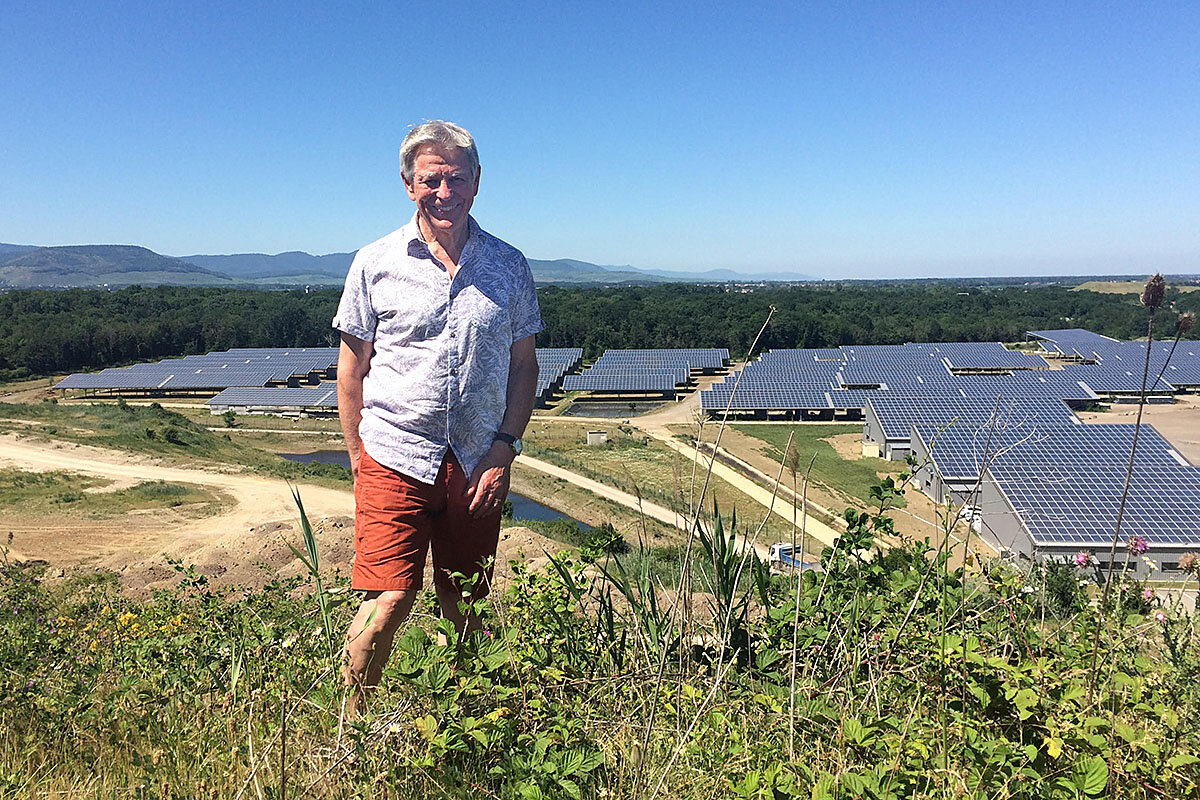A school bus with hoofs: How one town embraces sustainability
Loading...
| Ungersheim, France
A blazing sun beats down on Richelieu’s back as 9-year-old Enola pets his mane in the school parking lot. Her brother Nathan jumps behind onto the carriage, the vinyl seats sticky in the 95-degree heat. When around a dozen children are squeezed together, driver Sébastien Bruntz picks up the reins and calls out “Allez, trot!” The rhythmic clacking of hoofs picks up across the pavement.
Richelieu is one of three horses that alternates throughout the week taking children to and from school in Ungersheim. In this town of 2,200 in the Alsace region of France, most kids walk to school. But for those living the farthest out, the horse and carriage is one fewer trip for parents.
“This doesn’t use any gas so there’s no pollution,” says 11-year-old Arthur, who’s taking the horse and carriage home for lunch today. “Plus, it’s just really nice. We all talk together. Honestly, I love it.”
Why We Wrote This
The environmentally friendly initiatives that Ungersheim, France, has adopted over the past few decades offer ideas for other communities. Local leaders across Europe are taking notes. This story is part of an occasional series on “Climate Realities.”
The horse and carriage-cum-school bus got a few laughs – and grumbles from drivers pressed for time – when the idea was launched a decade ago, says Mr. Bruntz, but it’s normal now. It’s just one of dozens of measures that Jean-Claude Mensch has worked to implement since he became mayor of Ungersheim in 1989.
The food in the Ungersheim school cafeteria is 100% organic, and solar panels crisscross the rooftop of the local swimming pool. A massive wood-burning heater serves seven local buildings, and the use of pesticides is banned here. On the edge of town, nine families live in an eco-hamlet dedicated to zero waste and zero carbon emissions.
It’s all part of Ungersheim’s steady evolution toward sustainability and economic autonomy. Since 2005, Ungersheim has reduced the town’s greenhouse gas emissions by 600 tons per year and saved more than €150,000 ($167,000) – all without raising taxes.
“The ecological transition is a desire to change things in order to respect the ecological balance, meaning we’re not above nature – we’re part of nature,” says Mr. Mensch. “We don’t claim to try to change the world, but we’re hoping to do our part.”
While Mr. Mensch’s dedication to environmentally friendly initiatives borders on obsession, other local leaders in Europe are looking to Ungersheim as a potential model to follow. As heat waves like the ones that have recently hit Europe extend across the globe more frequently, individual communities are feeling a renewed sense of urgency to take climate action.
“Tackling climate change at the local level is a mindset,” says Antoine Guillou, energy and climate change coordinator at the Paris-based think tank Terra Nova. “It has to be integrated into every big decision.”
“We decided to move here”
Ungersheim’s solar farm sits in a low valley on the edge of town, sandwiched between the lush Vosges Mountains and the mirage-like dense green of Germany’s Black Forest. Just a few miles away is Fessenheim, the oldest and most controversial nuclear power plant in France.
Mr. Mensch has been vocal in his opposition to Fessenheim – which French President Emmanuel Macron has promised to close by 2020 – as well as France’s reliance on nuclear energy, which makes up over 70% of its total electricity production.
By contrast, Ungersheim’s eco-transition has hinged on renewable energy. In addition to the solar farm – the largest in the Alsace region with a capacity of 5.3 megawatts – the town has built solar panels over practically every public building. Many residents have followed suit, rebuilding their rooftops to become more eco-friendly.
“We used to live in a bigger city. But we decided to move here for all of the environmental actions the town has taken,” says resident Laetitia Scherding, as she accompanies her son home on the horse and carriage.
Many businesses in the area accept “radis,” the local currency, as a way for the economy to become more self-sufficient. And the town is in the process of completing a sustainable farm, which will include a craft brewery, fruit juice press, vegetable market, and nature center – with the idea that the money earned will be pumped back into the local economy. Like most initiatives here, the farm is another way for Ungersheim to not only reduce its environmental footprint, but its dependence on outside financial support.
“National governments have a very strong role in setting objectives ... but some sectors have a local aspect, in which case it’s up to local governments to define the most effective solutions [to a given problem],” says Mr. Guillou of Terra Nova. “But historically in France, local governments are limited and are very dependent on the national government for financial means.”
“Somewhere between old and new”
Despite appearances, Ungersheim has no intention of shunning modernity or moving backward in time. Mr. Mensch says he is not a hard-liner and makes concessions when need be. For instance, while horses are employed for a portion of the agricultural production, tractors are used as well.
“We take a hybrid approach, somewhere between old and new,” says Kenji Sakai, the supervisor of Ungersheim’s agricultural management. “You can combine low- and high-tech. One shouldn’t exclude the other.”
Although a horse and buggy may not be realistic for big cities, local leaders across France and the rest of Europe are increasingly getting in touch with Mr. Mensch to find out how to roll out their own sustainable initiatives, especially after the 2016 film “Qu’est-ce qu’on attend?” (What are we waiting for?”) featured the town’s eco-transition.
Independently of this small Alsatian town, sustainability initiatives are gaining ground across the country. In Paris, Mayor Anne Hidalgo has committed much of her mandate to going green, working to ban diesel-powered vehicles by 2024 and reducing traffic across the city. In 2016 legislators passed a law to stop food waste, and next year what's being billed as the largest rooftop urban farm in the world – at 150,000 square feet – will open in Paris.
“There is a desire to go local, to return to the past, especially in terms of food consumption,” says Sébastien Abis, an associate research fellow at the French Institute for International and Strategic Affairs. “We’re progressing in France when it comes to sustainable development, but it will be even better in the future.”
While Mr. Mensch’s ideas for Ungersheim’s future seem positively unlimited, his transition mission has not come without some small trade-offs. The town’s flower boxes could use sprucing up and the roads and sidewalks are in need of a repaving – both things that are important to the French small-town aesthetic.
“Some things have fallen a little to the wayside, but we have priorities,” says Mr. Mensch, as a drive along the main road reveals a blur of unkempt purple flowers. “For example, when we redo the roads, we don’t earn anything ... but when we invest in the ecological domain, we win. ... People are slowly coming around to the idea.”
This story was produced with support from an Energy Foundation grant to cover the environment.
Editor’s note: This story has been updated to clarify the location of the urban farm.







